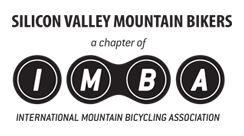Well, it has been a little while since the IMBA Summit, and I put talking about it on the agenda for the next ROMP meeting, so here I am trying to focus my thoughts. Basically the rest of the conference was about future trends in mountain biking, Grant Writing, and Grassroots organizing and motivating.
THE FUTURE OF MOUNTAIN BIKING?
On June 21, Joey Klein, the Original Trail Care Crew guy for IMBA, and now the trail solutions manager talked about where he’d been and what he’d seen building and consulting on trails around the globe. In many ways what he presented suggested the future of mountain biking much better than I have in an upcoming newsletter article.
He showed a lot of special bike parks full of jumps and berms. You see “volunteer” jump parks crop up all over the place. I know of ones in Mountain View, Palo Alto and Belmont. Because people are building these on marginal lands, it is clear there is a lot of pent up demand for them.
He showed trails with easier and harder lines, developing a progression for riders to develop skills over time. This reminds me of the trail structure in Soquel Demo Forest, where there is always an ATV line around the log overs, teeter toters, skinnies and other technical trail features. It reminds me of the lines that are developing on the high side along the Canyon trail in Monte Bello. People are seeking out and creating more technical places to ride.
GRANT WRITING
This was presented by Elizabeth Train from Bikes Belong which gives money to “get more people on more bikes more often” and Justin Vander Pol of BackCountry Bicycle Club who turned his volunteer President position into a full time paid staff position through fundraising and grant writing.
Justin talked about getting access to a grants database. Once you have that you can:
1) identify the money
– big grants as easy to get as small grants
– How competitive is the grant?
2) Choose project based on available money
– Get approval for the project before you apply for the grant
3) Involve youth
4) Mention health benefits
5) Involve other groups
6) Include environmental restoration in the project if possible
7) Show taking club to next level
8) Use volunteers to include user groups and cut project expenses
There was a guy there who mentioned federal highway money is available through a recreational trails program, but in CA this must be done with a county or the state. Organizations like the Youth Corps, Boy Scouts and v-o-cal.org can provide muscle.
If you need to provide matching funds, sometimes you can use volunteer hours at $18.50 / hour
Where’s the money?
– Paid Service database
– Hardware Stores
– Bikes belong (need to involve bike shop)
– Service clubs (Rotary, Lions)
– Local Businesses – contact community affairs
Grant Scoring
– Call, develop relationship, and ask the sponsor what they are looking for, detail
– Make it easy to score – skimmable – not too long
– Help sell the corporate image
– be memorable
– Follow up after project. Prgress reports, ribbon cutting
– Show guarantee for success
Potential ROMP Project (Got any Ideas?)
– Stevens Canyon Bridges
– Gunn HS Bike Park
– Windy Hill Spring Trail Re-route
– Lost Trail widening, opening to bikes
– Sierra Azul Single track
– Stevens Creek Trail Bike Park
PARTNERS FOR CONSERVATION
Was a panel consiting of Jim Hassenauer of IMBA, somebody from Canada parks and Jenn Dice of IMBA. The idea was how can we build relationships with land managers? What can we accomplish? Our relationships should address super-ordinate goals – goals that we can only acheive by working together.
GRASSROOTS ORGANIZING
Part of this was presented by WORCA, Whistler’s local club. They have a paid secretary and put on some awesome events. He thought that stagnant membership could be addressed by involving youth and families, having courses or clinics, getting leadership to rotate, but make sure the new leadership is qualified. These people need to be actively recruited.
One of the new trail care crew people talked about throwing events as a way to revitalize your club. Here is a list of things she suggested as events
– Organized rides
– Post-ride food and fun
– Niche rides – chick rides, hick rides, ick rides
– Bike Derby (No Dabbing, last track standing wins)
– chopper / cruiser ride
– Bar Night (AKA what you really look like)
– Informal race, time trial
– trail maintenance – treat it like an event
– Skills clinics & Maintenance clinics
– Movie Premier & shop parties
– Photo Scavenger hunt – Get yourself in a picture with the following . . .
– Weekend Trips
– Formalized races and festivals
triple events (dirt crit + Technical time trial + XC)
slip and slide finish (remember the eighties?)
– Make a kid smile program (at risk kids out on trails)
– Fat tire festival
Steps to throw a successful eventevent
1) you can do it
2) determine goals – financial, volunteers etc
3) Make it fun
4) Spread the word – web, forum, email, bike shops, trail heads
5) Organize event volunteers –
– job discriptions
– treat vols well
– Don’t micromanage
6) Execute – stay positive, learn from mistakes, run event from the back
7) Recap afterwards
8) Make it fun – prizes – crappier the better
9) donations are different than membership – what will the money do?



